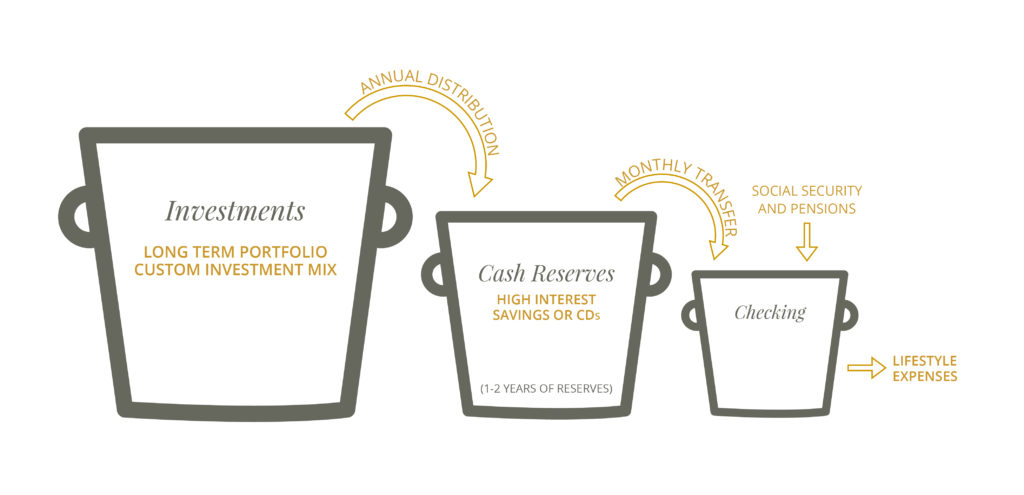Replace Income in Retirement Using the Bucketing Approach

Retirement is a daunting transition. There are big changes in identity (“I am no longer defined by my profession”), relationships (“I don’t see the guys much anymore”), and time (“What do I do with 40 more hours?”).
One of retirement’s most challenging aspects are the financial changes. If you were an employee, you reliably received a paycheck for showing up and doing your job. Now, you no longer have to show up, but the paycheck usually stops showing up as well. If you were a business owner, you may not have been paid by someone else, but exiting the business most likely meant moving from some type of income to an asset (like a payout) instead.
The switch to retirement comes with many money decisions. And many of these choices are irrevocable. For example, once you decide how to activate Social Security, you have very little recourse to change your mind. Decisions made now impact decades to come:
- When do I activate Social Security?
- How do I get health insurance?
- Do I move my workplace retirement account, such as a 401(k), Thrift Savings Plan, or 403(b)?
- Should the investments in my retirement accounts change now?
- Do I take a pension lump sum or the monthly payout?
- If I take the monthly payout, should I go Single Life, Joint Life, Period Guarantee, etc?
- Would an annuity be good for me?
Pensions are now few and far between. A generation ago, retirees had fewer choices to make. Many careers ended with generous pensions that, combined with Social Security, replaced all or most of their original income. There was little to do except stop going to work, cash the pension check, and enjoy spending it. However, in 1950 the average male retiree could expect to live another eight years; now that average is above 18 years. With life expectancies rising, this option is mostly a thing of the past.
Some retirees create their own “pensions” using annuities. Unfortunately, most need a substantial amount of money to recreate their income due to high fees and low percentage payouts . This method allows you to outsource investment risks to an insurance company, but the trade-off is that your heirs may receive nothing after your death. You’re also exposed to more risk from inflation with locked-in monthly payments. Some annuities include annual adjustments, but if costs rise faster than income, your purchasing power could erode greatly over time.
This leaves many retirees with investment accounts as a main source of income. Combined with Social Security, retirees are left covering their expenses using investment accounts. Pulling income out of a large IRA, 401(k), or similar account is a challenging shift. For decades, they have been putting as much money as feasible into these accounts. At retirement, the tide turns from saving to withdrawing. Taking money out of these previously “off-limits” accounts can be psychologically difficult.
The “Bucketing Approach” can help make this mental shift easier. To help retirees make the shift into providing their income, we often use a “bucketing” strategy. This approach divides retirees’ money into three different buckets according to long-term, medium, and immediate needs.
- Bucket 1: Investment accounts holding long-term assets, invested according to your long-term strategy. This fluctuates with the underlying investments, but the goal is to provide enough return over retirement to fund the retirees needs. We usually send annual distributions from this Bucket to…
- Bucket 2: A high-interest savings account with reserves and next year’s expenses. Currently, realistic interest here is usually 2 to 3 percent. This account provides a buffer from the volatility of the invested accounts. If a major market correction happens, the retiree knows they have money available to weather turbulence without needing to sell investments at a loss. Often, to replace the feel of a paycheck, this account automatically transfers a monthly amount into…
- Bucket 3: A checking account for today’s living expenses. Other sources of income (such as Social Security, pensions, or rental income) also flow into this account and may reduce the amount needed monthly from the other buckets.

The Bucketing Approach has many psychological benefits, including being able to get a regular monthly “paycheck” from your savings deposited into Bucket 3 and the security of being able to see your cash reserves in Bucket 2. The goal is to provide stability over market fluctuations, while still leaving assets invested for long-term potential growth.
This brings predictability to cash flow in retirement, even in years the market is not cooperating. By separating the timing of monthly expenses from the need to sell investments, the Bucketing Approach helps reduce “sequence-of-returns risk.” This is the risk that poor returns early in retirement mean withdrawals limit potential growth needed for later retirement.
The actual distribution process is different for every client. However, using this method can help new retirees settle into a new stage of life with less stress and worry. If you need help making a smooth transition into retirement, reach out to one of our financial planners!


